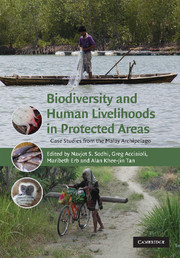Book contents
- Frontmatter
- Contents
- List of contributors
- Acknowledgements
- 1 General introduction
- Part I Conservation needs and priorities
- 2 Introduction to Part I
- 3 Delineating Key Biodiversity Areas as targets for protecting areas
- 4 A Master Plan for Wildlife in Sarawak: preparation, implementation and implications for conservation
- 5 Indonesia's protected areas need more protection: suggestions from island examples
- 6 Birds, local people and protected areas in Sulawesi, Indonesia
- 7 Importance of protected areas for butterfly conservation in a tropical urban landscape
- 8 Biodiversity conservation and indigenous peoples in Indonesia: the Krui people in southern Sumatra as a case study
- 9 Involving resource users in the regulation of access to resources for the protection of ecosystem services provided by protected areas in Indonesia
- 10 Conclusion to Part I
- Part II Conservation with and against people(s)
- Part III Legal and governance frameworks for conservation
- 29 General conclusion
- Index
10 - Conclusion to Part I
from Part I - Conservation needs and priorities
Published online by Cambridge University Press: 12 November 2009
- Frontmatter
- Contents
- List of contributors
- Acknowledgements
- 1 General introduction
- Part I Conservation needs and priorities
- 2 Introduction to Part I
- 3 Delineating Key Biodiversity Areas as targets for protecting areas
- 4 A Master Plan for Wildlife in Sarawak: preparation, implementation and implications for conservation
- 5 Indonesia's protected areas need more protection: suggestions from island examples
- 6 Birds, local people and protected areas in Sulawesi, Indonesia
- 7 Importance of protected areas for butterfly conservation in a tropical urban landscape
- 8 Biodiversity conservation and indigenous peoples in Indonesia: the Krui people in southern Sumatra as a case study
- 9 Involving resource users in the regulation of access to resources for the protection of ecosystem services provided by protected areas in Indonesia
- 10 Conclusion to Part I
- Part II Conservation with and against people(s)
- Part III Legal and governance frameworks for conservation
- 29 General conclusion
- Index
Summary
The chapters in this part show that protected areas in the Malay Archipelago may be severely threatened. Thus, protecting areas of global as well as regional significance is essential if we are to conserve biodiversity. Protected areas, for example, are crucial to bird species, and likely other taxa, of high-conservation concern, and should therefore remain one of the fundamental conservation strategies. Existing protected areas need to be better protected, and future protected areas should be carefully planned using both biological and sociological underpinnings. Challenges in the delineation and tangible management of protected areas can be best negated through a balance between biological and socioeconomic needs.
While current measures of protection may not be largely effective in most protected areas, understanding of effective strategies undoubtedly grows with conservation failures. Clearly, innovative new ideas and conservation tools are needed to both maintain existing protected areas and recruit new ones. Important considerations should be the expansion of current protected areas through restoration and reforestation, inclusion and education of local stakeholders about demarcation and conservation goals. Conservation attitudes of rural communities are generally positive. Negative conservation attitudes increase the intensity of resource harvesting in the protected areas. Therefore, fostering favourable support for conservation may help to alleviate at least some resource-harvesting pressures. More ecological and sociological studies are urgently needed so that tangible conservation actions and the improvement of conservation attitudes can be derived.
- Type
- Chapter
- Information
- Biodiversity and Human Livelihoods in Protected AreasCase Studies from the Malay Archipelago, pp. 139 - 140Publisher: Cambridge University PressPrint publication year: 2007



